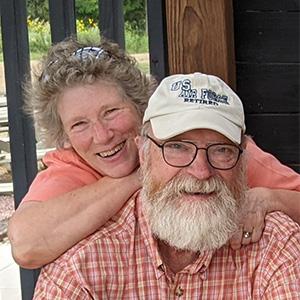Sandy Ahrens

Sandy Ahrens believes in being thorough.
Two months after Sandy got an all-clear from her annual physical and routine mammogram, she felt a lump in her breast. Sandy was worried: Her grandmother died of breast cancer when Sandy was a kid. “I just remember the look on my mom’s face back then, and that was really hard,” Sandy recalls.
To her doctor, OB/GYN Deb Suppes, MD, the lump felt like a cyst. To be on the safe side, Dr. Suppes ordered a 3D mammogram and ultrasound.
The ultrasound found the lump deep inside Sandy’s breast, on her chest wall. “It was buried like a seed inside a squash,” Sandy says. A biopsy diagnosed invasive ductal carcinoma.
Sandy met with surgeon Ellie Cohen, MD. This was March 2020: The pandemic was just starting to shut down elective surgeries, and restrict hospital and clinic visitors. Sandy’s husband Mike was able to join her for the surgeon appointment. “He took notes; it was a blessing to have him there,” Sandy recalls. The breast care nurse navigator was there too, to help Sandy understand her diagnosis and treatment options.
One option was lumpectomy and possibly radiation. But the tumor had appeared so soon after her screening mammogram; was it growing that fast? Her grandmother died within six months of her own diagnosis. “There were all kinds of questions running through my mind,” Sandy recalls. “I really struggled with making the decision.”
Sandy asked members of NH+C’s Breast Cancer Support Group how they made decisions for their own treatment. “Every single one of them shared their story,” Sandy says. “It was very helpful.”
Still, Sandy vacillated. In the end, she chose a mastectomy because the tumor may have been growing fast. “I wanted to have the tumor out and get on with treatment and then be done,” she says.
“When I woke up after surgery, there were candles in my room,” Sandy recalls. The nurse navigator brought them in “to give me a glimmer of hope.”
There was no cancer in Sandy’s lymph nodes. Genomic testing showed Sandy had a better chance of her cancer not recurring in five years if she had chemotherapy. “Luckily, I only need four treatments,” she says.
The nurse navigator also set up physical and occupational therapy for Sandy. Appointments shortly after her diagnosis established a baseline for Sandy’s arm strength and mobility, and measurement of her arms to track possible swelling from lymphedema after chemotherapy. Sandy had PT for several months after surgery to rebuild strength and mobility, and had OT when she developed lymphedema after chemo.
The nurse navigator “set up all my appointments with the surgeon and the oncologist, and for surgery, chemo, PT and OT,” Sandy recalls. “That was such a relief. All I had to do was show up.”
Sandy finished chemotherapy in October 2020. She continued after that with a mammogram or MRI every six months; an oncologist visit every 3-6 months (gradually shifting to once a year); and 10 years taking an aromatase inhibitor to lower the risk of recurrence by lowering her estrogen levels.
Sandy’s been cancer-free for two years.
Having all her care close to home was “fantastic,” Sandy says: “To be able to just drive to the hospital here in town and then come home again was great.”
Though her diagnosis was the same as her grandmother’s, her experience is completely different. “It’s amazing what they can do now compared to generations ago,” Sandy says. And people are open to talking about their cancer experience now, with family and friends and in support groups. “You’re able to get information that helps you make your own medical decisions, and get advice about caring for yourself during treatment from others who’ve been through it.”
Her advice for someone with a new diagnosis? “Ask lots of questions. The trouble is, you don’t know what kind of questions to ask,” Sandy says. That’s where the nurse navigator can help: “She’d say, ‘These are questions you may have,’ and was very open and willing to help me anticipate the information I would need.”
Because thorough information leads to the best care.
